
Study: Research
Lumped or Big: Effects of unconditional cash transfer fade out two years later in Urban Hiran, Somalia
Publication year:
2019
English
Format:
pdf (270.3 KiB)
Publisher:
Save the Children International,Save the Children Somalia/Somaliland
Cash transfers have become a preferred approach to address household basic needs in both development and humanitarian programming in recent years. In Somalia, since the 2011 drought, unconditional cash transfers (UCT) have continued to increase as the intervention of choice to enable at-risk populations to meet to their basic needs. Other than supporting consumption, there is always an underlying desire to build on the productive impacts of cash transfers to support communities’ resilience. Traditional cash transfers paid in installments have shown to be successful in supporting households to smooth their consumption but does not necessarily translate to household asset building and subsequent resilience. Design changes to UCTs even of the same value such as lumping (paying once instead of several installments) have shown some benefits in other settings, especially stimulating investment in micro-enterprises. On the other hand, existing micro-enterprises owned by the poor often are credit constrained, preventing these entities from attaining their high marginal returns to capital.
Leveraging on a humanitarian and development-oriented project that sought to support micro-business development in addition to usual humanitarian UCTs, this study sought to fulfill two objectives. First was to test marginal long-term effects of capital transfers over and above UCTs of a typical amount. Secondly, was to establish the long-term value of lumping UCTs instead of delivering in installments. The study featured four types of transfers allocated through public lottery:
- Small UCT of $100 in two monthly instalments,
- Small one-off business grant of $100,
- “Medium” business grant of $500, and
- “Large” business grant of $1,000.
Except the instalment arm, the other three arms also received one week business skills training. Using a panel sample of 361 beneficiaries surveyed thrice: just before transfers, five months after transfers and 2 years after transfers, this study presents both short-term and ‘long-term’ effects in urban areas of Hiran Somalia.
The study finds lumping UCTs and business grants were beneficial to micro-enterprises in short-term, not in terms of increasing ownership of non-farm micro-enterprises, but helping them survive the drought situation five months after the transfers. These protective benefits fade away by the second year after the transfers. Nevertheless, surviving micro-enterprises had better business practices, had higher net-worth and were making larger profits both in the short-term and in the long-term attributable to the additional cash injection and training. From a business angle, the medium grant recipients made nearly the same amount of profits from their businesses as those receiving large business grants if not even larger in some cases. This demonstrated that the $500 grant is more cost-effective than $1,000 grant in the long-term. The income shock from the transfers temporarily increased cash available at household level thus stimulating savings, expenditure and subsequent food security; however, as the drought situations worsened, they withdrew these saving and shrunk their expenditure and hence fading the positive effects. In terms of effects on children, the study finds mixed effects. For example, while the transfers increased amount households spent on their children’s health, these expenditures were short-lived and engendered in favor of male children. In some cases, the study documents withdrawal of younger children from school was plausibly a coping mechanism to household resource constraints occasioned by the 2017 drought, enrolment to school has not regained to the previous levels. Therefore, the study recommends lumping UCTs installments as an option to improve effectiveness over a similar value when the goal of the transfers is to increase micro-enterprise investments. Besides when it comes to business grants for micro-enterprises, medium-sized grants ($500) presents the most cost-effective option than larger grants ($1,000). To have sustained effects, these grants can consider including regular UCTs for consumption smoothing and help micro-enterprises survive during emergencies and beyond. Finally, methods of making cash transfers sensitive to investment on children should be considered.
Read full abstract
Authors
View & Download
Document information
Format
Content type
Country
Region
Topics
Rights
© Author/Publisher
Found a mistake? Help us improve!
If you have noticed a document assigned to the wrong author or any other inaccuracies, let us know! Your feedback helps us keep our data accurate and useful for everyone.
Share
Link
